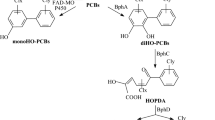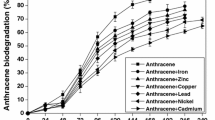Abstract
Rhodococcus rhodochrous was grown in the presence of oneof three plasticizers: bis 2-ethylhexyl adipate (BEHA), dioctyl phthalate (DOP) ordioctyl terephthalate (DOTP). None of the plasticizers were degraded unless anothercarbon source, such as hexadecane, was also present. When R. rhodochrous was grownwith hexadecane as a co-substrate, BEHA was completely degraded and the DOP was degraded slightly. About half of the DOTP was degraded, if hexadecane were present.In all of these growth studies, the toxicity of the media, which was assessed usingthe Microtox assay, increased as the organism degraded the plasticizer. In each case, therewas an accumulation of one or two intermediates in the growth medium as the toxicityincreased. One of these was identified as 2-ethylhexanoic acid and it was observed forall three plasticizers. Its concentration increased until degradation of the plasticizershad stopped and it was always present at the end of the fermentation. The other intermediatewas identified as 2-ethylhexanol and this was only observed forgrowth in the presence of BEHA. The alcohol was observed early in the growth studies with BEHA and haddisappeared by the end of the experiment. Both the 2-ethylhexanol and 2-ethylhexanoicacid were shown to be toxic and their presence explained the increase of toxicity asthe fermentations proceeded. The appearance of these intermediates was consistent with similar degradation mechanisms for all three plasticizers involving hydrolysisof the ester bonds followed by oxidation of the released alcohol.
Similar content being viewed by others
References
Albro PW (1975) The metabolism of 2-ethylhexanol in rats. Xenobiotica 5: 625-636
Albro PW, Chapin RE, Corbett JT, Schroeder J & Phelps JL (1989) Mono-2-ethylhexyl phthalate, a metabolite of di-(2-ethylhexyl) phthalate, causally linked to testicular atrophy in rats. Toxicol. Appl. Pharmacol. 100: 193-200
Albro PW & Moore B (1974) Identification of the metabolites of simple phthalate diesters in rat urine. J. Chromatogr. 94: 209-218
Albro PW & Thomas RO (1973) Enzymatic hydrolysis of di-(2-ethylhexyl) phthalate by lipases. Biochem. Biophys. Acta. 306: 380-390
Baker RWR (1978) Diethylhexyl phthalate as a factor in blood transfusion and hemodialysis. Toxicology 9: 319-329
Barber ED, Fox JA & Giordano CJ (1994) Hydrolysis, absorption and metabolism of di(2-ethylhexyl) terephthalate in the rat. Xenobiotica 24: 441-450
Beam HW & Perry JJ (1974) Microbial degradation and assimilation of n-alkyl-substituted cycloparaffins. J. Bacteriol. 118: 394-399
Cartwright CD, Thompson IP & Burns RG (2000) Degradation and impact of phthalate plasticizers on soil microbial communities. Environ. Toxicol. Chem. 19: 1253-1261
Cassidy DP & Irvine RL (1999) Use of calcium peroxide to provide oxygen for contaminant biodegradation in a saturated soil. J. Hazard. Mater. 69: 25-39 352
Castle L, Mercer AJ, Startin JR & Gilbert J (1988) Migration from plasticized films into foods. 3. Migration of phthalate, sebacate, citrate and phosphate esters from films used for retail food packaging. Food. Addit. Contam. 5: 9-20
Chaineau CH, Morel J, Dupont J, Bury E & Oudot J (1999) Comparison of the fuel oil biodegradation potential of hydrocarbonassimilating microorganisms isolated from a temperate agricultural soil. Sci. Total. Environ. 227: 237-247
Choudhry S, Lox F & Decroly P (1994) The migration of plastic components: The quantification of influences from mechanical stresses and vibrations. Packag. Technol. Sci. 7: 163-167
Colon I, Caro D, Bourdony CJ & Rosario O (2000) Identification of phthalate esters in the serum of young Puerto Rican girls with premature breast development. Environ. Health. Perspect. 108: 895-900
Dahlstrom RV & Jehnig JH (1973) U.S. Patent 3,773,621
Dirven HAAM, van den Broek PHH & Jongeneelen FJ (1993) Determination of four metabolites of the plasticizer di(2-ethylhexyl)phthalate in human urine samples. Int. Arch. Occup. Environ. Health. 64: 555-560
Duvnjak Z, Cooper DG & Kosaric N (1983) Effect of nitrogen sources on surfactant production by Arthrobacter paraffineus ATCC 19558. Microb. Enhanced Oil Recovery, 66-72.
Eaton RW & Ribbons DW (1982) Metabolism of dibutylphthalate and phthalate by Micrococcus sp. strain 12B. J. Bacteriol. 151: 48-57
Elcombe CR & Mitchell AM (1986) Peroxisome proliferation due to di(2-ethylhexyl) phthalate (DEHP): species differences and possible mechanisms. Environ. Health. Perspect. 70: 211-219
Elnabarawy MT, Robideau RR & Beach SA (1988) Comparison of three rapid toxicity test procedures: Microtox, Polytox, and activated sludge respiration inhibition. Toxic. Assess. 3: 361-370
Fall RR, Brown JL & Schaeffer TL (1979) Enzyme recruitment allows the biodegradation of recalcitrant branched hydrocarbons by Pseudomonas citronellolis. Appl. Environ. Microbiol. 38: 715-722
Faouzi MA, Dine T, Luyckx M, Gressier B, Goudaliez F, Mallevais ML, Brunet C, Cazin M & Cazin JC (1994) Leaching of diethylhexyl phthalate from PVC bags into intravenous teniposide solution. Int. J. Pharm. 105: 89-93
Graham PR (1973) Phthalate ester plasticizers. Why and how they are used. Environ. Health. Perspect. 3: 3-12
Jackson MA, Labeda DP & Becker LA (1996) Isolation for bacteria and fungi for the hydrolysis of phthalate and terephthalate esters. J. Ind. Microbiol. 16: 301-304
Jobling S, Reynolds T, White R, Parker MG & Sumpter JP (1995) A variety of environmentally persistent chemicals, including some phthalate plasticizers, are weakly estrogenic. Environ. Health. Perspect. 103: 582-587
Kaiser KLE, McKinnon MB & Fort FL (1994) Interspecies toxicity correlations of rat, mouse and Photobacterium phosphoreum. Environ. Toxicol. Chem. 13: 1599-1606
Keith Y, Cornu MC, Canning PM, Foster J, Lhuguenot JC & Elcombe CR (1992) Peroxisome proliferation due to bis(2-ethylhexyl) adipate, 2-ethylhexanol and 2-ethylhexanoic acid. Arch. Toxicol. 66: 321-326
Keyser P, Pujar BG, Eaton RW & Ribbons DW (1976) Biodegradation of the phthalates and their esters by bacteria. Environ. Health. Perspect. 18: 159-166
Kurane R, Suzuki T & Takahara Y (1980) Microbial degradation of phthalate esters. Part VII. Metabolic pathway of phthalate esters by Nocardia erythropolis. Agric. Biol. Chem. 44: 523-527
Kyrides LP (1933) U.S. Patent 1,923,938
Lhuguenot JC, Mitchell AM, Milner G, Lock EA & Elcombe CR (1985) The metabolism of di(2-ethylhexyl) phthalate (DEHP) and mono(2-ethylhexyl) phthalate (MEHP) in rats: in vivo and in vitro dose and time dependency of metabolism. Toxicol. Appl. Pharmacol. 80: 11-22
Loftus NJ, Laird WJD, Steel GT, Wilks MF & Woollen BH (1993) Metabolism and pharmacokinetics of deuterium-labeled di-2-(ethylhexyl) adipate (DEHA) in humans. Food. Chem. Toxicol. 31: 609-614
Marino F, Karp JM & Cooper DG (1998) Biomass measurements in hydrocarbon fermentations. Biotechnol. Techniques 12: 385-388
O'Grady DP, Howard PH & Werner AF (1985) Activated sludge biodegradation of 12 commercial phthalate esters. Appl. Environ. Microbiol. 49: 443-445
Oh Y-S, Shareefdeen Z, Baltzis BC & Bartha R (1994) Interactions between benzene, toluene, and p-xylene (BTX) during their biodegradation. Biotechnol. Bioeng. 44: 533-538
Reynolds L, Blok J, De Morsier A, Gerike P, Wellens H & Bontinck WJ (1987) Evaluation of the toxicity of substances to be assessed for biodegradability. Chemosphere 16: 2259-2277
Rowland IR, Cottrell RC & Phillips JC (1977) Hydrolysis of phthalate esters by the gastro-intestinal contents of the rat. Food. Cosmet. Toxicol. 15: 17-21
Saeger VW & Tucker ES (1976) Biodegradation of phthalic acid esters in river water and activated sludge. Appl. Environ. Microbiol. 31: 29-34
Samsonowa AS, Aleshchenkowa ZM, Syomochkina NF & Baikova SV (1996) Microbial decontamination of effluents from phthalate esters. DECHEMA Monogr. 133: 607-610
Schaeffer TL, Cantwell SG, Brown JL, Watt DS & Fall RR (1979) Microbial growth on hydrocarbons: terminal branching inhibits biodegradation. Appl. Environ. Microbiol. 38: 742-746
Schmezer P, Pool BL, Klein RG, Komitowski D & Schmaehl D (1988) Various short-term assays and two long-term studies with the plasticizer bis(2-ethylhexyl) phthalate in the Syrian golden hamster. Carcinogenesis 9: 37-43
Sepic E, Trier C & Leskovsek H (1996) Biodegradation studies of selected hydrocarbons from diesel oil. Analyst 121: 1451-1456
Shanker R, Ramakrishna C & Seth PK (1985) Degradation of some phthalic acid esters in soil. Environ. Pollut., Ser. A 39: 1-7
Staples CA, Peterson DR, Parkerton TF & Adams WJ (1997) The environmental fate of phthalate esters: a literature review. Chemosphere 35: 667-749
Syldatk C, Stoffregen A, Wuttke F & Tacke R (1988) Enantioselective reduction of acetyldimethylphenylsilane: A screening with thirty strains of microorganisms. Biotechnol. Lett. 10: 731-736
Takahashi T, Tanaka A & Yamaha T (1981) Elimination, distribution and metabolism of di-(2-ethylhexyl)adipate (DEHA) in rats. Toxicology 22: 223-233
Tepper LB (1973) Phthalic acid esters-an overview. Environ. Health. Perspect. 3: 179-182
Wagner M & Nicell JA (2002) Detoxication of phenolic solutions with horseradish peroxidase and hydrogen peroxide. Water Res. 36: 4041-4052
Webb JS, Nixon M, Eastwood IM, Greenhalgh M, Robson GD & Handley PS (2000) Fungal colonization and biodeterioration of plasticized polyvinyl chloride. Appl. Environ. Microbiol. 66: 3194-3200
Author information
Authors and Affiliations
Rights and permissions
About this article
Cite this article
Nalli, S., Cooper, D.G. & Nicell, J.A. Biodegradation of plasticizers by Rhodococcus rhodochrous . Biodegradation 13, 343–352 (2002). https://doi.org/10.1023/A:1022313810852
Issue Date:
DOI: https://doi.org/10.1023/A:1022313810852




